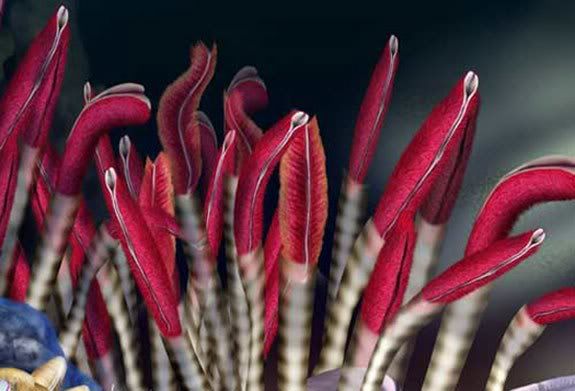
GIANT TUBE WORMS
Giant tube worms, even thought they are a complex organism, can survive in temperatures up to 80 degrees. Giant tube worms don't have mouths, guts, or any from of digestive system. They have a mutual relationship with trillions of bacteria that live inside its long, tube shaped tissue. For every ounce of tissue in a tube worm's insides, there are roughly 285 million bacteria. The "hair" on the top of the giant tube worm holds many red blood cells, the hemoglobin of which binds with the hydrogen sulfide form the vent water and sends the chemical down through the tube worm to the bacteria, who oxidize the hydrogen sulfide and change carbon dioxide into compounds that can be used by the tube worms as a form of nourishment. The giant tube worm is hard to classify because of its dependence on the chemosynthetic bacteria for energy processing. It is considered a secondary producer because of its relationship with the bacteria.

THE HYDROTHERMAL VENT OCTOPUS: VULCANOCTOPUS
The octopi found near hydrothermal vents have translucent skin because they don't have colour pigments. their eyes have no irises. Not very much is known about these creatures but it is assumed that their eyes serve little or no purpose. They have eight legs with two rows of suckers on each leg and the males have one modified tentacle for reproduction. The Vulcanoctopus (so named for its habitat- underwater "volcanoes" of water) is a consumer and eats the many crustaceans and crabs that live on the walls of a hydrothermal vent. they trap their prey in the webs of their tentacles or simply grab a hold of them with their tentacles. Female Vulcanoctopi have never been observed or studied in either captivity or the wild. There has even been a recorded sighting of one male inserting its sperm into another male octopus of a different species! They like to stay in groups and it is suggested by biologists that the males and females stay separated except for reproduction. The formation and closeness of these groups contributes to the spread of a parasitic copepod that feeds off the octopi.

SQUAT LOBSTER
Squat lobsters may look a bit like lobsters but they are actually a type of crab. They are generally 10 cm long. They have 10 "legs", two of which are hidden from sight most of the time, and two of which have long, large claws. Squat lobsters, though very closely related to hermit crabs, do not have shells and instead hide in crevasses and under rocks with only their two claws exposed. They eat a variety of smaller organisms and are not above scavenging in the sand for a long dead morsel of food. They have been known to occasionally steal food from the slower moving sea anemones that also frequent the hydrothermal vent. Squat lobsters are secondary consumers and really they will eat anything they can get their claws on. There have been several reports of Squat lobsters eating wood. They are basically the goat of the Hydrothermal vent. they have a commensalism relationship with the giant ube worms, which they hide in when a predator comes near.
Good explanation of mutualism with the tube worms and the bacteria.
ReplyDeleteMention of commensalism but could be more clearly explained.
You did include your trophic levels but you could you could represent how your organisms fit into them in a clearer way than just describing them.
ReplyDeleteYou missed out on the ecological INTERACTIONS part of the assignment. The parts you did do are not very well represented.
Everything else is fantastic. 43/50
Mau yang lebih ????? ayam tarung
ReplyDeletesabung ayam laga bangkok taji pisau
ReplyDeleteayo bergabung dengan bolavita khusus new member lgsg di berikan 10%
ReplyDeletetanpa ribet dan masih banyak bonus2 lain nya
semua di berikan tanpa ribet pelayanan terbaik 24 jam
depo wd secepat kilat ^^
sabung ayam filipin
info lbh lanjut :
WA: +628122222995